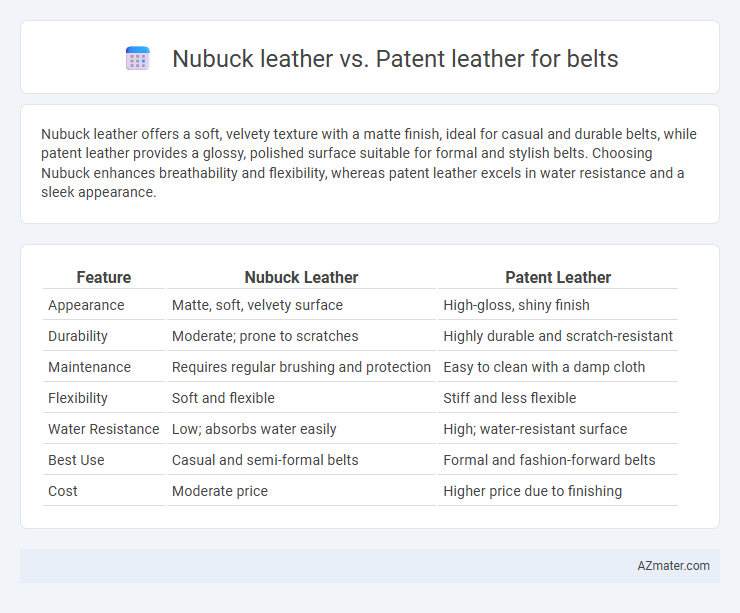Nubuck leather offers a soft, velvety texture with a matte finish, ideal for casual and durable belts, while patent leather provides a glossy, polished surface suitable for formal and stylish belts. Choosing Nubuck enhances breathability and flexibility, whereas patent leather excels in water resistance and a sleek appearance.
Table of Comparison
| Feature | Nubuck Leather | Patent Leather |
|---|---|---|
| Appearance | Matte, soft, velvety surface | High-gloss, shiny finish |
| Durability | Moderate; prone to scratches | Highly durable and scratch-resistant |
| Maintenance | Requires regular brushing and protection | Easy to clean with a damp cloth |
| Flexibility | Soft and flexible | Stiff and less flexible |
| Water Resistance | Low; absorbs water easily | High; water-resistant surface |
| Best Use | Casual and semi-formal belts | Formal and fashion-forward belts |
| Cost | Moderate price | Higher price due to finishing |
Introduction to Nubuck and Patent Leather
Nubuck leather, made from the outer side of a hide, features a soft, velvety texture achieved by sanding or buffing the grain, offering a matte, luxurious finish ideal for a sophisticated belt look. Patent leather is characterized by its glossy, mirror-like surface created through a coating process that enhances durability and provides a sleek, shiny appearance suitable for formal belts. Both materials differ significantly in texture and finish, impacting their style, maintenance, and suitability for various occasions.
What is Nubuck Leather?
Nubuck leather is a type of top-grain cattle hide sanded or buffed on the grain side to create a soft, velvety surface with a slight nap. This leather offers a matte finish and a suede-like texture, making it more breathable and flexible compared to patent leather. Ideal for belts, nubuck provides a sophisticated, understated look while requiring careful maintenance to prevent stains and water damage.
What is Patent Leather?
Patent leather is a type of leather coated with a high-gloss, shiny finish created by applying a lacquer or varnish, making it water-resistant and easy to clean. Unlike nubuck leather, which has a soft, matte, and textured surface due to buffing the grain side, patent leather offers a sleek and polished look ideal for formal belts. The durability and reflective quality of patent leather make it a popular choice for belts requiring a sophisticated and dressy appearance.
Appearance: Nubuck vs Patent Leather Belts
Nubuck leather belts showcase a soft, velvety texture with a matte finish that offers a subtle, sophisticated look suitable for casual and semi-formal wear. Patent leather belts feature a glossy, high-shine surface that provides a sleek, polished appearance, making them ideal for formal occasions. The visual difference is pronounced: nubuck's muted elegance contrasts sharply with patent leather's reflective, eye-catching sheen.
Durability and Wear Resistance Comparison
Nubuck leather offers moderate durability with a soft, velvety surface that is prone to scuffs and stains, requiring regular maintenance to preserve its appearance. Patent leather provides superior wear resistance due to its glossy, coated finish that effectively repels water and resists scratches, making it ideal for belts subjected to frequent use. While nubuck belts offer a unique texture and aesthetic, patent leather belts outperform in longevity and ease of cleaning.
Comfort and Flexibility Factors
Nubuck leather offers superior comfort and flexibility for belts due to its soft, brushed surface and natural breathability, allowing it to conform easily to the waist for extended wear. Patent leather, characterized by its glossy, coated finish, tends to be stiffer and less breathable, which can reduce comfort during prolonged use. The inherent suppleness of nubuck makes it an ideal choice for belts requiring both comfort and adaptive fit, while patent leather suits more formal appearances with less emphasis on flexibility.
Maintenance and Cleaning Requirements
Nubuck leather belts require regular brushing with a suede brush to remove dirt and maintain their soft, velvety texture, while avoiding water exposure to prevent staining. Patent leather belts demand wiping with a damp cloth and occasional polishing with a patent leather cleaner to preserve their glossy finish and prevent cracking. Both types benefit from storage in a cool, dry place to extend durability and appearance.
Style and Fashion Suitability
Nubuck leather offers a matte, velvety texture that complements casual and smart-casual outfits, adding a subtle sophistication ideal for relaxed or rustic styles. Patent leather belts, characterized by their glossy, reflective finish, suit formal and dressy occasions, enhancing polished looks with a sleek, high-shine appeal. Choosing between Nubuck and Patent leather depends on the desired fashion statement: understated elegance versus bold, refined glamour.
Cost Considerations: Nubuck vs Patent Leather
Nubuck leather belts generally cost more than patent leather due to the labor-intensive buffing process required to achieve their soft, velvety finish. Patent leather belts are typically more affordable, benefiting from a streamlined manufacturing process involving a glossy coating that reduces production time and cost. Choosing between the two often depends on budget constraints and desired aesthetic, as nubuck offers a premium look at a higher price point while patent leather provides a shiny, durable option for less.
Which Leather Belt Should You Choose?
Nubuck leather belts offer a soft, matte finish with a velvety texture, making them ideal for casual and smart-casual wear due to their breathability and natural appearance. Patent leather belts provide a glossy, polished surface that is perfect for formal occasions, offering durability and a sleek, high-shine look that resists stains and water. Choose nubuck leather if you prefer comfort and a less reflective style, while patent leather is best for a sophisticated, dressy aesthetic that demands attention.

Infographic: Nubuck leather vs Patent leather for Belt
 azmater.com
azmater.com